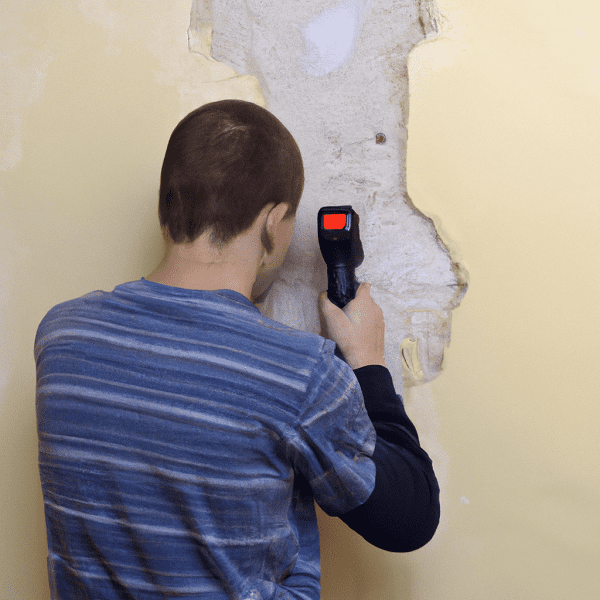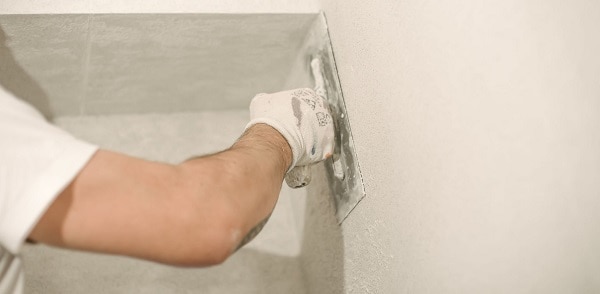Are you struggling to locate studs in your plaster walls?
You're not alone! Many people find it difficult to accurately locate studs when using a standard stud finder on plaster walls. Fortunately, there are some devices that can help you find studs in plaster walls without any hassle.
In this article, we'll explore the different types of stud finders that work on plaster walls. We'll also discuss how to use them properly to ensure that you get accurate results.
Let's get started!
What is a Stud Finder?
A stud finder is an electronic device that helps detect the position of wood and metal studs, joists, and beams behind walls and ceilings. It is a useful tool for DIYers who are looking to hang pictures, mount shelves, or do any type of wall repair.

The most commonly used type of stud finder works by sensing changes in electromagnetic fields. By holding it against a wall, its sensors can identify when they come into contact with metal framing inside the wall such as metal joists or wires in plaster walls.
Depending on the model you choose, some can be used to detect other objects like plumbing pipes or electrical outlets in addition to wood and metal studs.
Generally speaking, everyone should have a stud finder available for their home maintenance projects.
What are Plaster Walls?
Plaster walls are a unique home fixture composed of several thin layers of material that create a surface that’s stronger, smoother and more durable than other wall types.
Though they are common in older homes, they are still found in newly constructed buildings. They generally consist of three parts: the lath, a wooden framework; the plaster itself, which is applied over the lath; and a top coat for protection from moisture and wear.

One question that many people have is whether or not stud finders can be used to locate studs in plaster walls. The answer is yes – but with a few caveats.
Because stud finders use either magnetism or electrical current to detect density changes in the wall surface, plaster can present unique challenges to finding accurate readings if it’s extremely thick or if it has been patchworked over time.
Here are some tips on how to get reliable readings when using your stud finder on plaster walls:
Do Stud Finders Work on Plaster Walls?
Finding studs in plaster walls can be tricky, especially with an untrained eye. You may be wondering, do stud finders work on plaster walls?
The good news is, yes, stud finders do work on plaster walls – but it's important to understand how to use the tool correctly to get the best results.
We'll explain the process of using a stud finder on a plaster wall and how to ensure you're getting the best results:
Types of Stud Finders
When it comes to working on plaster walls, a stud finder is a simple and effective tool. All you have to do is run it over your wall and it will detect the presence of metal or wood, making any task easier.
There are different types of stud finders available and each one is designed for a specific purpose. It's important to know which one is best for your needs when selecting a stud finder for plaster walls.
No matter what kind of material your walls are made from – wooden planks, metal-infused lath and plaster sheets or concrete – having the right tool can make all the difference for successful project completion!
Make sure you select an appropriate technique based upon its compatibility with different types of materials before beginning any task involving use of a stud scanner on potentially intricate surfaces such as those commonly found in older homes where plaster was used extensively!
Magnetic Stud Finders
Magnetic stud finders are particularly useful for plaster walls. Plaster walls built before the 1950s often have metal lath strips that hold up the plaster and provide stability for the wall.
A magnetic stud finder can detect these pieces of metal hidden beneath the plaster, helping you accurately locate and mark studs in your wall. However, newer plaster walls might not have any metal support beneath them so if a magnetic stud finder doesn't pick up anything on your wall, you may need to consider other methods of finding a wall stud.
To use a magnetic stud finder on plaster walls, first start by scanning the area around your desired drilling location to ensure there is a stud or piece of metal behind the wall.
If nothing is detected, it is best practice to move around and scan larger areas until one is identified. Once you located a spot likely to contain a wall stud or piece of metal support strip in your plaster wall, mark it with pencil or tape.
By following this process you can save time and avoid unnecessary frustration when trying to drill into a plaster wall with an unknown structure behind it.
Electronic Stud Finders
An electronic stud finder is a device designed to identify the location of wooden framing studs in walls, ceilings, and floors. If you have a plaster wall in your home that you need to mount a shelf, hang a picture or complete any other handyman task, using an electronic stud finder can be helpful.
Plaster walls are tricky surfaces to work with when hanging anything since they are made of mostly drywall compound and not material like wood or metal. However, with the right tool and some caution, you can use an electronic stud finder on your plaster wall.
These devices use electro-magnetic fields to detect the presence of ferrous materials such as metal screws used in wall studs and framing lumber. Electronic stud finders usually include depth measurement so users can determine if they're drilling into another layer of drywall beyond their target surface material.
It’s important to remember that for plaster walls that are thick or more than 1 inch (2.54 cm) deep, metal detection is not always possible as the waves used for detection may not penetrate distant surfaces. Additionally, thick insulation behind plaster walls may also interfere with the effectiveness of an electronic stud-finder. In either case it’s best practice to test any wall before drilling into it; this will help prevent damage from unexpected wires or pipes behind the surface during home improvement projects.
Tips for Using a Stud Finder on Plaster Walls
Locating and marking the studs in your plaster walls is no easy feat. However, with the right tools and techniques, it can be done.
We will cover everything you need to know when it comes to using a stud finder on plaster walls.
Check the Thickness of the Wall
Stud finders are an effective tool for locating studs in drywall, but can also be used on plaster walls. Before you start, however, it is important to know the thickness of your wall.
While regular stud finders work with drywall of a certain thickness (about 3/8 inch), a deeper scanning stud finder is necessary for thicker material like lath & plaster and double brick walls which can be up to two inches thick.
Plaster walls are generally very hard, making it difficult for the magnet in traditional stud finders to detect the nails or screws that other types of walls might have. However, deep-scanning electronic models help overcome this challenge by emitting an electronic pulses that penetrates through the plaster layer and registers metal objects such as nails or screws behind it.
After selecting a deep-scanning model, you are ready to begin searching for wood studs in your plaster wall.
Check the LCD screen on your device regularly while you’re running it over your wall since there might be complications due to things like metals pipes or other metal objects hidden behind the wall.
Also note that some electronic models may not register metal screws or nails located closer than 1 ½ inches away from each other – so remember to occasionally refer back to a manual measurement tape especially when dealing with old vintage homes where metal supports may already be installed within one single wall section.
Lastly it is critical that you only mark locations detected by your device and don't make any assumptions as every mark should correspond directly with a physical confirmation before drilling any holes into your wall.
Scan the Wall in Multiple Directions
When scanning for studs in plaster walls, it is important to use a stud finder to sweep the wall in multiple directions.
Start by scanning a vertical line from the top of the wall to the bottom and then switch directions horizontally from left to right. Don’t just scan once along each direction – do it multiple times until you’re sure you have a clear signal from the stud finder.
It may be helpful to mark lightly with pencil in between scans so that you can keep track of where you’ve already checked.
Because plaster walls are much thicker than drywall, it is important to make sure your device is able to detect both wood and plastic studs because different construction techniques can be used on plaster walls that result in different types of materials being used as supports.
You may also want to consider other materials that are hidden behind plaster such as:
that could potentially show up during your scan if they run close enough alongside your intended target. Make sure you use some caution when transferring weight from one point on a wall which may potentially be carrying more load than it should by either overloading an unseen support or risking structural damage if nothing is found at all.
Try investing in an advanced stud finder with improved accuracy or calibrate your device according to manufacturer instructions before starting any project.
Use a Pencil to Mark the Studs
For uses when trying to locate studs in plaster walls, it may be helpful to use a pencil to mark the outline of each stud.
Because plaster walls are made up of several layers, it is difficult to identify the exact location of each stud. You can go around and lightly mark the outline of each stud with a light pencil line so that you can see where they all are when looking at the wall from a distance.
This method can save time and frustration when trying to find nailing points in plaster walls.
Another thing to consider is using a specialized tool designed for detecting studs in plaster walls. These tools usually have some sort of scanner technology that offers more accuracy than typical stud finding devices used on drywall or lath walls.
These types of tools are also equipped with depth sensors which allow them to differentiate between regular plaster, wallboard, and lath & plaster constructions. The extra convenience can save you time and effort when attempting to hang things on plaster walls.
In any case, using a combination of these methods should ensure that you’re able to accurately locate the best places for nailing into your plaster wall with ease!
Final Words
Whether you are hanging a heavy object on a wall or simply mounting a piece of artwork, finding a stud behind walls is essential to make sure the object is securely attached. A stud finder can help locate the studs and allow you to safely anchor your item onto the wall.
Do stud finders work on plaster walls? The answer is yes, they do! While you may experience some difficulties in finding the studs due to the thickness of the plaster, most stud finders are able to detect them with precise accuracy.
Ultimately, if you want to get accurate results, the best option is to invest in a stud finder that specifically works on plaster walls.
